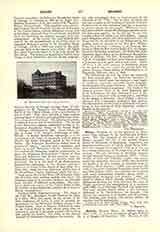

Boiardo, MATTEO MARIA, an Italian poet, b. about 1434, at, or near, Scandiano (Reggio-Emilia); d. at Reggio, December 20, 1494. The son of Giovanni di Feltrino and Lucia Strozzi, he was of noble lineage, ranking as Count of Scandiano, with seigniorial power over Arceto, Casalgrande, Gesso, and Torricella. Boiardo was an ideal type of the gifted and accomplished courtier possessing, at the same time, a manly heart and deep humanistic learning. Up to the year of his marriage to Taddea Gonzaga, the daughter of the Count of Novellara (1472), he had received many marks of favor from Borso d’Este, Duke of Ferrara, having been sent to meet Frederick III (1469), and afterwards visiting Pope Paul II (1471), in the train of Borso. In 1473 he joined the retinue which escorted Eleonora of Aragon, the daughter of Ferdinand I, to meet her spouse, Ercole, at Ferrara. Five years later he was invested with the governorship of Reggio, an office which he filled with signal success till his death, except for an interval (1481-86) during which he was governor of Modena.
His great poem of chivalry and romance “L’Orlando innamorato” (Scandiano, 1495), consisting of sixty-eight cantos and a half, was begun about his thirty-eighth year, interrupted for a time by the Venetian war, then resumed, to be left unfinished on account of the author’s death. To material largely quarried from the Carlovingian and Arthurian cycles the Count of Scandiano added a gorgeous superstructure of his own. As the plot is not woven around a single pivotal action, the inextricable maze of most cunningly contrived episodes must be linked, first, with the quest of beautiful Angelica by love-smitten Orlando and the other enamored knights, then with the defense of Albracca by Angelica’s father, the King of Cathay, against the beleaguering Tartars, and, finally, with the Moors’ siege of Paris and their struggle with Charlemagne‘s army. The whole, in spite of a lack of finish and sundry rhythmical deficiencies, formed a magnificent work of art, echoing from every ottava the poet’s ardent devotion to Love and Loyalty, shedding warmth and sunshine wherever the lapse of ages had rendered the legends colorless and cold, and opening a path which Ariosto and Tasso were soon to tread. Still, the poem, after sixteen editions, was not to be republished for nearly three centuries. Francesco Berni‘s rifacimento, or recasting of “L’Orlando” appeared in 1542, and from that date till 1830, when Panizzi revived it, Boiardo’s name was well-nigh forgotten. A similar fate had befallen the count’s “Rime” (Scandiano, 1499), which Panizzi’s edition (London, 1835), snatched from oblivion. In his youth Boiardo had been a successful imitator of Petrarca’s love strains. Evidence of his more severe attainments is furnished in an “Istoria Imperiale”, some versions from Nepos, Apuleius, Herodotus, Xenophon, etc., and by his Latin Eclogues. A comedy, “Il Timone” (1487?), adds little to his credit. See Francesco Berni.
EDOARDO SAN GIOVANNI

